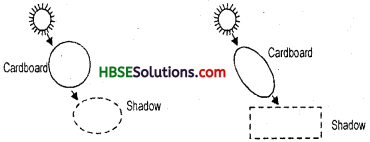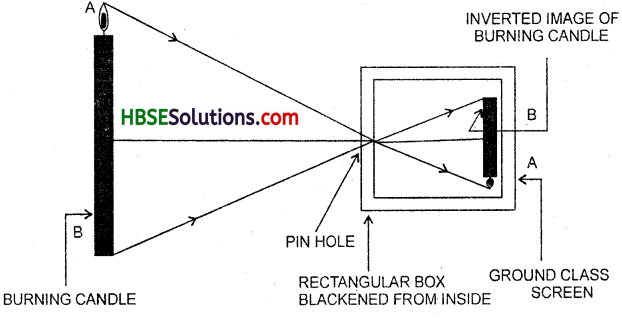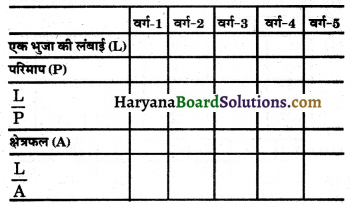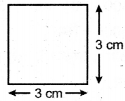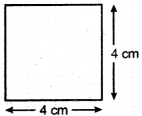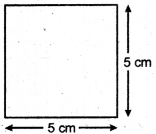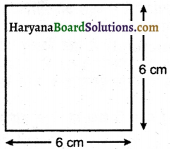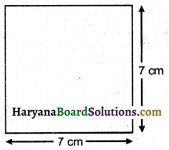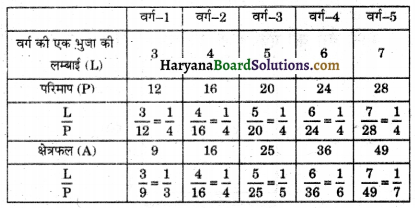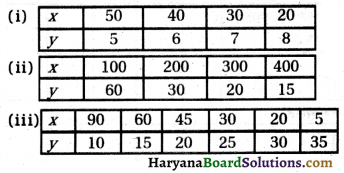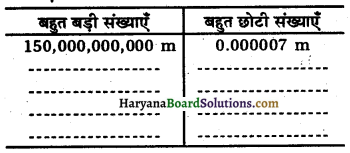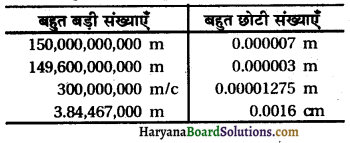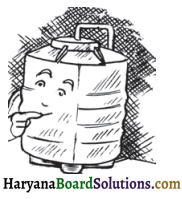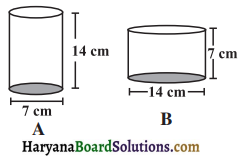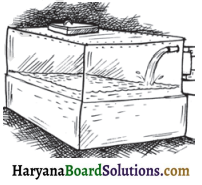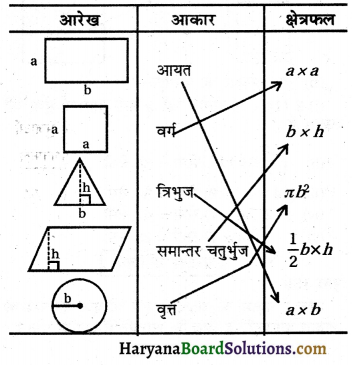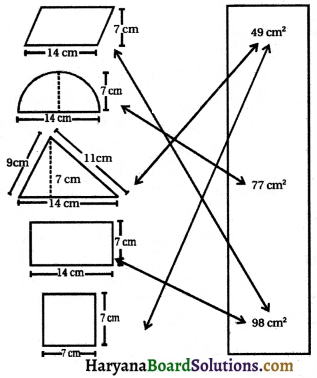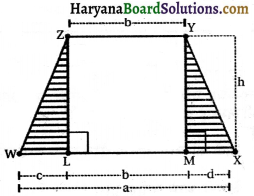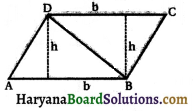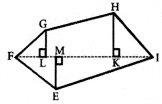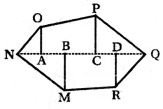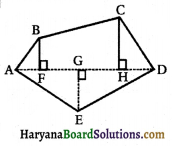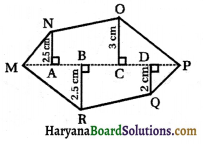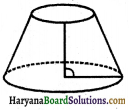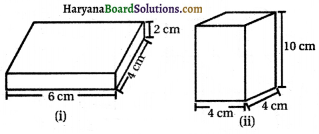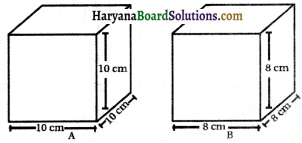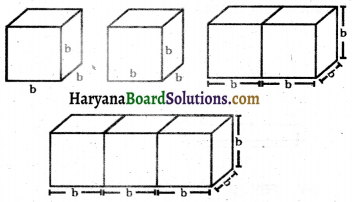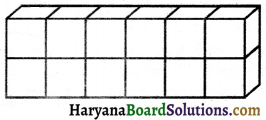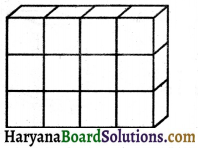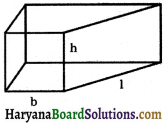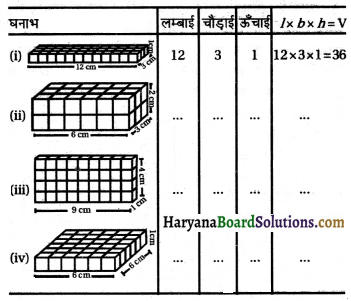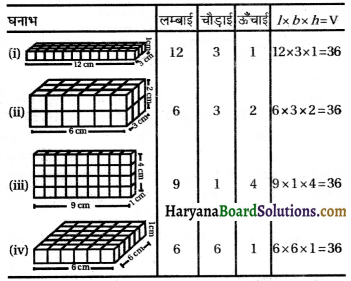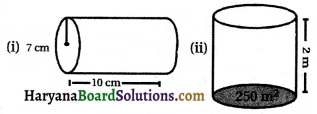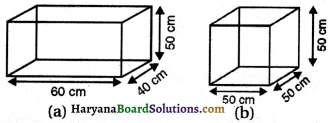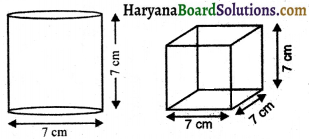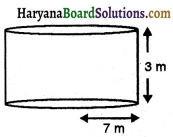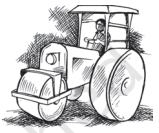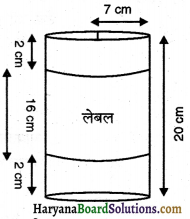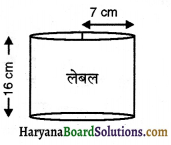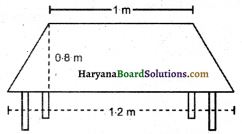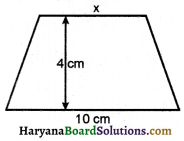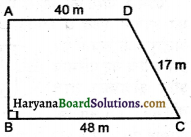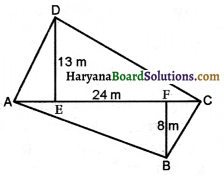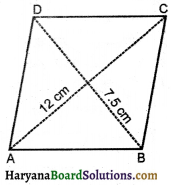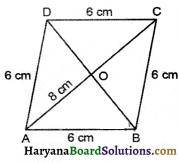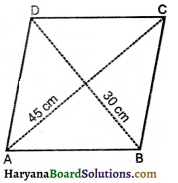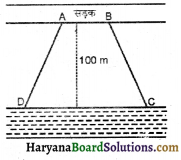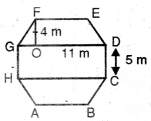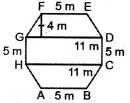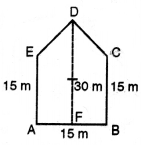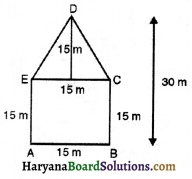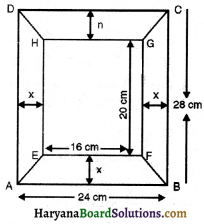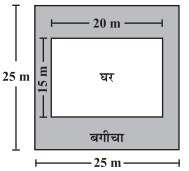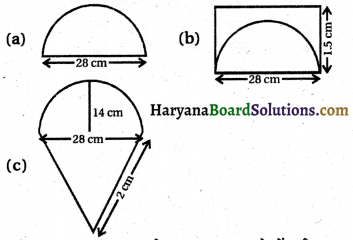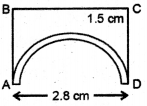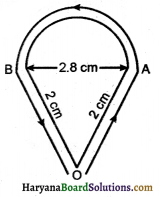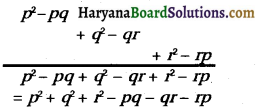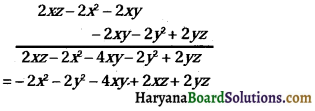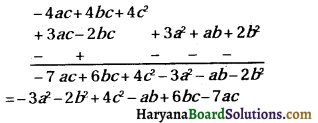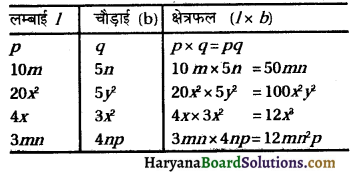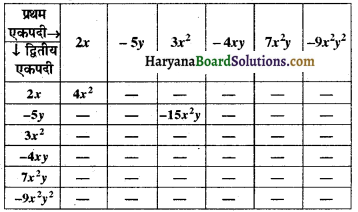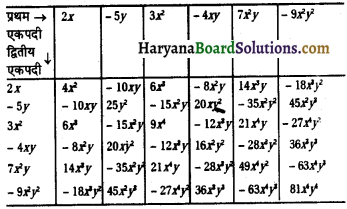HBSE 6th Class Science Solutions Chapter 10 Motion and Measurement of Distances
Haryana State Board HBSE 6th Class Science Solutions Chapter 10 Motion and Measurement of Distances Textbook Exercise Questions and Answers.
Haryana Board 6th Class Science Solutions Chapter 10 Motion and Measurement of Distances
HBSE 6th Class Science Motion and Measurement of Distances Textbook Questions and Answers
Exercises
Question 1.
Give two examples each of modes of transport used on land, water and air.
Answer:
Modes of transport used are:
(i) Land: Buses, railways, cars etc.
(ii) Water: Boats, ships.
(iii) Air: Air planes, gas balloons, etc.
Question 2.
Fill in the blanks:
(i) One metre is ………….. cm.
(ii) Five kilometres is ………….. m.
(iii) Motion of a child on a swing is ……………. .
(iv) Motion of a needle of a swing machine is ………….. .
(v) Motion of a wheel of a bicycle is …………… .
Answer:
(i) 100
(ii) 5000
(iii) oscillatory motion
(iv) oscillatory motion
(v) circular motion.
![]()
Question 3.
Why can a pace or a foot step not be used as a standard unit of length?
Answer:
The pace or foot step has different lengths for different persons. So they cannot be used as a standard unit of length.
Question 4.
Arrange the following lengths in their increasing magnitude:
1 metre, 1 centimetre, 1 kilometre, 1 millimetre.
Answer:
1 millimetre > 1 centimetre > 1 metre > kilometre.
Question 5.
The height of a person is 1.65 m. Express it into cm and mm.
Answer:
(i) 165 centimetre
(ii) 1650 millimetre.
Question 6.
The distance between Radha’s home and her school is 3250 m. Express this distance into kilometre.
Answer:
3.250 kilometre.
Question 7.
While measuring the length of a knitting needle, the reading of the scale at one end is 3.0 cm and at the other end is 33.1 cm. What is the length of needle?
Answer:
Length of needle = 33.1 cm
(-) 03.0 cm
= 30.1 m
Question 8.
Write the similarity and dissimilarity between the motion of a bicycle and a ceiling fan that has been switched on.
Answer:
The motion of a bicycle and a ceiling fan are in circular motion. Thus both show similar motion. But the ceiling fan moves without changing its position while the bicycle moves with changing its position with time. This shows dissimilarities between two motions.
Question 9.
Why could you not use an elastic measuring tape to measure distance? What would be some of the problems you would meet in telling someone about a distance you measured with an elastic tape?
Answer:
We should not use elastic measuring tape to measure distance because the length of the measuring tape will increase when we pull or stretch the tape for measuring the length. The length may increase or decrease due to its elasticity. So we cannot measure the correct length by elastic measuring tape. The length measured by this tape either will be more or less depending on the elasticity of tape.
Question 10.
Give two examples of periodic motion.
Answer:
Examples of periodic motion:
(i) Motion of a pendulum.
(ii) Motion of a branch of a tree.
(iii) Motion of a child on a swing.
![]()
HBSE 6th Class Science Motion and Measurement of Distances Important Questions and Answers
Very Short Answer Type Questions
Question 1.
Give one example where your estimate about the length of an object may be wrong.
Answer:
To measure the length of a table with stretched palm.
Question 2.
Give two examples of measurements that you make in your daily life.
Answer:
(i) To measure the length of cloth before sewing.
(ii) To measure the weight of vegetables before buying.
Question 3.
Name the S.I. unit of length.
Answer:
Metre (m).
Question 4.
Name the unit of length which should be used to express the thickness of a coin?
Answer:
Millimetre (mm).
Question 5.
What is measurement?
Answer:
The comparison of an unknown quantity with a standard known quantity is known as measurement.
Question 6.
Define unit.
Answer:
A quantity adopted as a standard of measurements of a physical quantity is called a unit.
Question 7.
What is a year?
Answer:
Time taken by the earth to revolve around the sun is called a year.
Question 8.
Name two devices used to measure length.
Answer:
(i) Metre scale
(ii) Screw gauge.
![]()
Question 9.
If you are sitting in a moving bus, you are at rest or in motion?
Answer:
We are in motion.
Question 10.
Is your class room at rest or in motion?
Answer:
The class room is at rest.
Question 11.
Is the hour is hand of a wall- clock at rest or in motion?
Answer:
Hour’s hand of the wall-dock is in motion.
Question 12.
What type of motion do the vehicles on a straight road perform?
Answer:
The vehicle motion is linear.
Question 13.
What type of motion do the wheels of a bicycle perform?
Answer:
Circular motion.
Question 14.
Give two examples of periodic motion.
Answer:
(i) Rotation of the earth on its axis.
(ii) Moon moves around the sun.
Question 15.
Give one example of an object changing their speed while in motion.
Answer:
Wind changes the speed of man while running with open umbrella.
Question 16.
Name two types of motion.
Answer:
(i) Circular motion
(ii) Oscillatory motion.
![]()
Question 17.
Give two examples of rectilinear motion.
Answer:
(i) A bullet fired from a rifle.
(ii) A boy sliding down a slope.
Question 18.
Give two examples of rotational motion.
Answer:
(i) The motion of blades of a ceiling fan.
(ii) Seconds hand in a clock.
Question 19.
What is motion?
Answer:
A body is said to be in motion when it changes its position with time.
Question 20.
Give two examples of linear motion.
Answer:
(i) Motion of bus in a straight line.
(ii) Motion of bullet.
Question 21.
Give an example of objects which move in a line.
Answer:
Falling of a ball freely.
Question 22.
Give an example of objects which move in a circle.
Answer:
Spinning wheel, blades of fan.
Question 23.
Give an example 9f objects which move to and fro.
Answer:
Pendulum of a wall clock.
Question 24.
Define translatory motion.
Answer:
Wheel of a car.
Question 25.
Give one example of rotatory motion.
Answer:
Spinning of a top, spinning wheel’s.
![]()
Short Answer Type Questions
Question 1.
State two precautions which you should take while using a metre-scale to measure the length of an object.
Answer:
(i) The scale should be placed along the length to measure. It should be very close to the objects to be measured.
(ii) Eye must be kept vertical above the end point of the object or point where the measurement is taken.
Question 2.
How do you measure the circumference of a one-rupee coin?
Answer:
To measure the circumference of coin wrap the thread around the coin. The length of the thread can be measured with the help of a metre scale.
Question 3.
Describe a method you would use to measure the thickness of a thin wire with the help of a metre scale.
Answer:
Wrap say 25 turns of thin wire around a pencil and see that the wrap should be very close to one another. The wire would form a coil. With the help of meter scale, measure the length of wire and divide it by total number of turns. It will be the thick-ness of a thin wire.
Question 4.
Write three rules which should be observed while writing symbols for S.I. units.
Answer:
Rules to be observed while writing S.I. units and their symbols:
(i) Symbols for units of quantities are to be written with a small letter. For example: symbol of Metre-m.
(ii) Symbol of unit named after a scientist is to be written in capital letters. Examples: Symbol for Kelvin-K.
(iii) Symbols for units are not to be followed by full stop. For example: Symbol for metre is m (and not m.)
Question 5.
Define circular motion.
Answer:
When the object moves along a circular track around a fixed axis. It is said to be in circular motion. Examples: Spinning top and spinning wheel.
Question 6.
Define oscillatory motion.
Answer:
A to and fro motion about its mean position is known as oscillatory motion.
![]()
Question 7.
Give some examples of oscillatory motion.
Answer:
Motion of a pendulum, motion of swing etc.
Question 8.
Give an example of objects for each of the following:
1. Object which moves in a line.
2. Object which moves in a circle.
3. Object which has a periodic motion.
Answer:
1. Light comes from the sun.
2. Movement of marry go around.
3. Motion of earth around the sun in one year.
Long Answer Type Questions
Question 1.
What is meant by a standard unit of measurement? Why is it necessary to have standard units of measurement? Name the SI unit of length. Write its symbol.
Answer:
Standard unit of measurement: A unit of measurement which has a fixed value which does not change from person to person or place to place, is called a standard unit of measurement.
It is necessary to have standard units of measurements for the sake of uniformity in measurements.
S.I. unit of length is metre. Its symbol of metre is m.
Question 2.
State the precautions which should be taken while using a metre scale to measure the length of an object (like a post card).
Answer:
Precautions to be taken while using a scale:
1. The scale should be placed parallel to the side of the object being measured. It should also be in a touch with the object being measured.
In Fig. 10.18(a) the scale is placed parallel to the side AB of the card which is to be measured. So, this is the correct placement of scale. This will give the correct reading for the length of card. From Fig. 10.18(a) we can see that the correct value of the length of card is 4.2 cm.
In Fig. 10.18(6), however, the scale is not exactly parallel to the side AB of the card being measured. So, it is a wrong placement of the scale. In this case the scale will give a wrong reading for the length of card (which will be greater than the actual length). For example, in Fig. 10.18(6), the scale shows a reading of 4.3 cm for the length of card, which is wrong.
2. While reading the scale, the eye must be placed vertically above the scale mark being read. If the eye is not vertically above the scale mark being read, then the reading becomes wrong.
In Fig. 10.19, the correct position of eye for reading the scale mark on the right side end of the card is at ‘A’ which is vertically above the scale mark being read. So, in Fig. 10.19, the correct reading of length of card from position A is 4.2 cm.
If we read the scale by keeping our eye somewhat towards left side at position B, then the scale reading appears to be 4.3 cm. And if the eye is kept at position C on the right side, then the scale reading appears to be 4.1 cm. The scale readings of 4.3 cm and 4.1 cm taken by keeping eye at positions B and C are wrong.
3. If the scale has a damaged zero mark or broken left end, measure the length of ah object starting from 1 cm mark of scale and then subtract 1 cm from the reading taken at the right end to get the actual length of object.
Question 3.
What is meant by: (a) circular motion and (b) rotational motion? Give two examples of circular motion and two examples of rotational motion.
Answer:
(a) Circular motion:
When an object moves along a circular path, it is called circular motion.
Examples:
(i) The movement of moon around the earth.
(ii) The move of earth around the sun:
(b) Rotational motion:
When an object turns (or spins) about a fixed axis, it is called rotational motion.
Examples:
(i) The motion of a spinning top.
(ii) The spinning of earth on its axis.
![]()
Question 4.
When an object is said to be in motion? Explain with the help of an example. State any four types of motion.
Answer:
An object is said to be in motion when its position changes with time. For example, when the position of a car changes with time, we say that car is moving or that the car is in motion. In Fig. 10.20, we see a car at position A in front of a house and tree at a particular urne. After 5 seconds we see the saine car at position B this quit far away from the house. This means that the position of this car is changing with time. So, we say that this car is in motion.
Four types of motion are:
(i) Rectilinear motion
(ii) Circular motion
(iii) Rotational motion and
(iv) Periodic motion.
(i) Rectilinear motion: Motion in a straight line is called rectilinear motion.
(ii) Circular motion: When an object moves along a circular path is called circular motion.
(iii) Rotational motion: When an object turns (or spins) about a fixed axis, it is called rotational motion.
(iv) Periodic motion: The motion which repeats itself after regular intetvals of time, is called periodic motion.
Question 5.
Give a method to measure the length of a pencil.
Answer:
To measure the length of a pencil, we choose a metre scale which should be placed along its length. In Fig. 10.21, zero mark on the scale coincides with the one end of the pencil and the reading coinciding with the other end of the pencil is taken. Since the ruler has some thickness, we may make an error if the eye is not correctly placed. The eye is to be placed exactly above the point where the measurement is to be taken as shown in Fig. 10.21 from the position A. The other end of the pencil coincides with 8.5 cm mark. The length of the pencil is 8.5 cm.
Motion and Measurement of Distances Class 6 HBSE Notes
- Different modes of transport are used to go from one place to another.
- In ancient times, people used length of a foot, the width of a finger and the distance of a step etc. as units of measurements. This caused confusion and a need to develop a uniform system of measurement arose.
- Now we use international system of unit (S.I. unit). This is accepted all over the world. 7.
- Metre is the unit of length in S.I, unit.
- Motion is the change in the position of an object. Motion may be rectilineal’, circular, rotational or
- periodic. gs
- Need of standard units: In ancient times, people used foot, arm, stretched palm as units of lengths. These methods were not satisfactory, because length of arm, foot and stretched palm vary from person to person. However if there are different units of length in the different parts of the world, it is very inconvenient for the exchange of scientific informations. Thus the need of standard units were felt. The unit which people agree to use as a basic unit for measurements, becomes a standard unit for that group of people for the sake of uniformity. Scientists all over the world have accepted following the standard unit for measuring length.
- The standard unit of length is metre. Its sub units are:
10 mm = 1 cm, 100 cm = 1 metre,
1000 m = 1 km, 3 x 10<sup>8</sup> m = 1 light year. - Measurements of length: In the S.I. system, the length is measured in unit metre (m). It is defined as the distance at 0°C between two lines drawn on a platinum irridium rod kept in the international bureau of weights and measure at screws near Paris. The following table shows the units of length and their relations to metre:
| Unit of length | Symbol | Value in metre |
| 1. Decimetre | dm | 0.1 or 10-1 m |
| 2. Centimetre | cm | 0.01 or 10-2 m |
| 3. Millimetre | mm | 0.001 or 10-3 m |
| 4. Micro-metre | pm | 0.000001 or HHm. |
- Rules for measuring length correctly:
→ Fig. 10.1 shows the correct position of the scale:
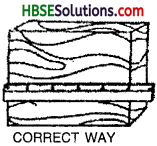
→ To measure the length of the block. It is necessary to place the scale along the length you want to measure more than the actual length.
→ The eye must be placed directly above the points you are reading otherwise there will be an error due to parallex. The magnitude of the error is minimum when the scale is next to the point. The error increases as the distance of scale from the object increases.
→ While measuring the length of an object, if one end of that lies somewhere between few mm marks of the scale. If it is more than 1/2 mm, count it 1 mm or if less than 1/2, neglect it.
→ If the zero mark of the scale is damaged or edge of scale is not smooth, then start measuring from another mark. The difference between two marks gives its correct length.
→ To minimise the error due to wrong marking on the measuring scale, measure the length several times, using different parts of the measuring scale and take average to get nearest correct length. - Measuring the length of a curved line: To measure the length of a curved line, we can use a thread or a divider from the geometry box.
→ Use a thread to measure the length of curved line AB (Fig. 11.4). Put a knot on the thread near one of its end and place this knot on point A. Now with the help of thumb and finger place a small portion of thread along the line. Now move the thumb which is towards the point A little further so that it takes the position of other thumb next portion of the line. Repeat this process till last end point B is reached.
→ Now, stretched the thread along a metre scale and measure the length between the knot and the mark on the thread. This gives the length of the curved line. - Motion is a state in which an object is steady or is at rest and the other object is moving. Motion may be rectilinear, circular, rotational or periodic.
- Periodic motion: Motion of a pendulum or motion of a branch of tree are examples of periodic motion. In such type of motion an object repeats its motion after a fixed interval of time.
HBSE 6th Class Science Solutions Chapter 10 Motion and Measurement of Distances Read More »

